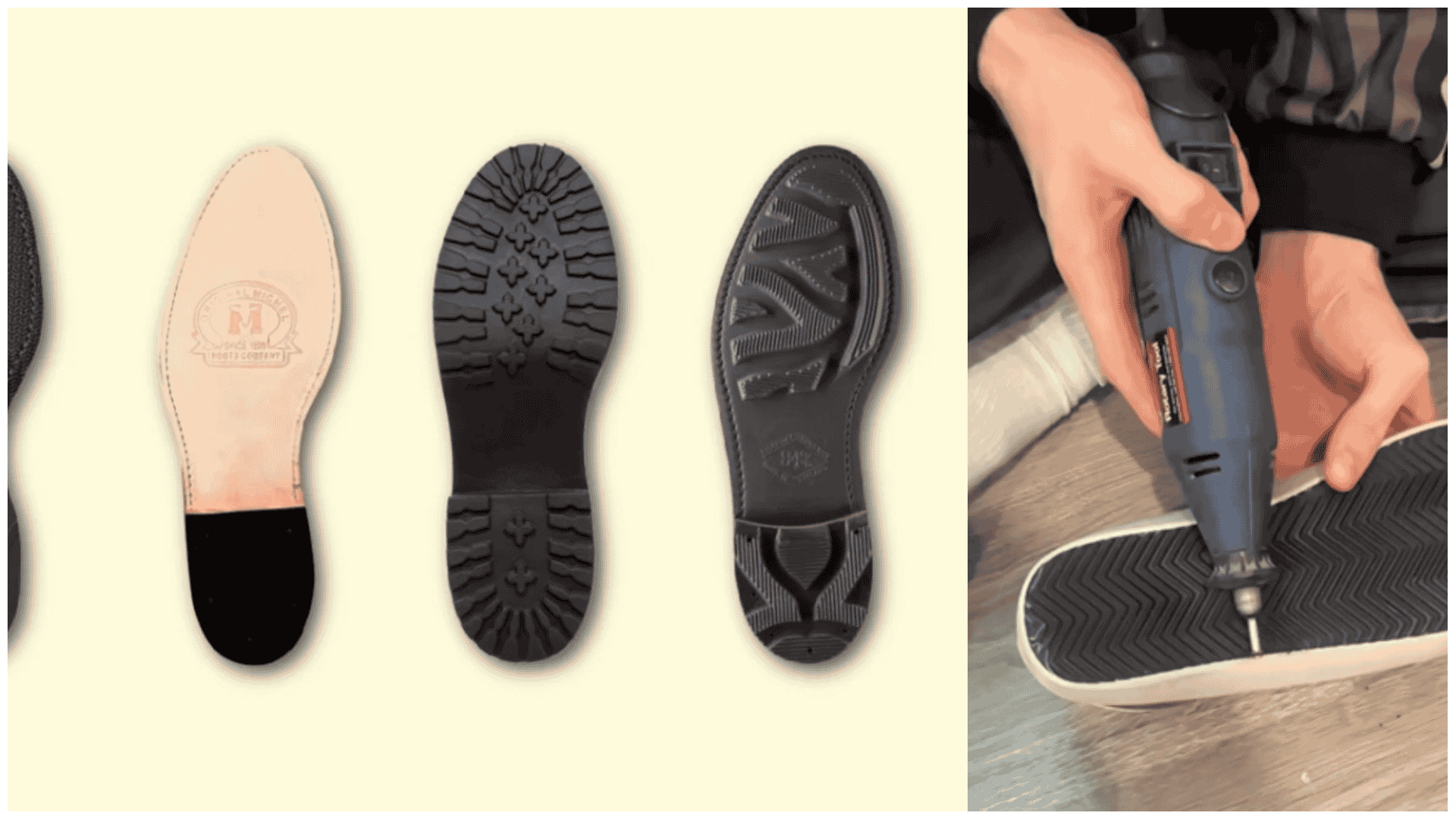Fashion
The Moissanite Rings Revolution: A Sparkling Alternative to Diamonds Rings
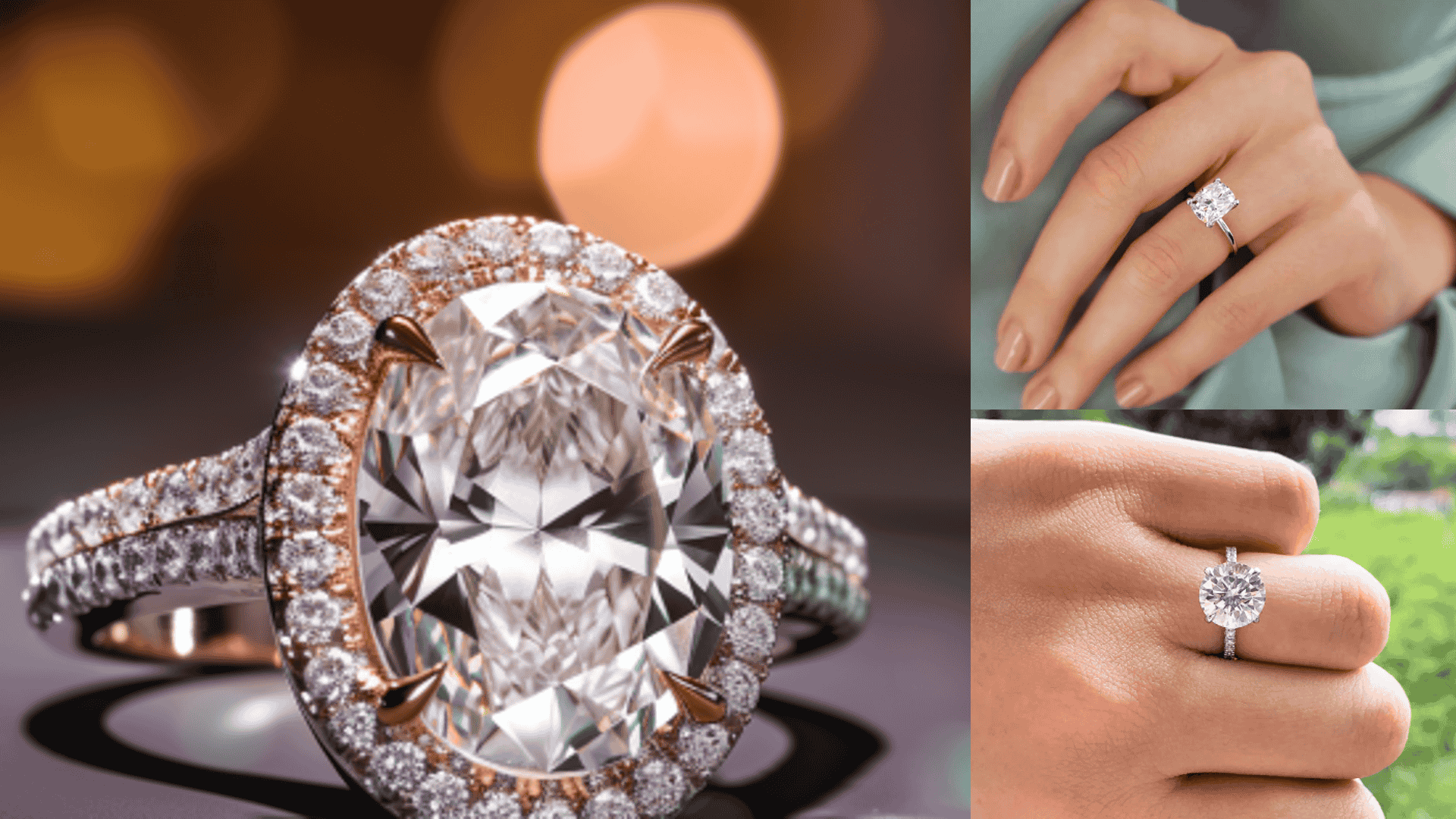
Moissanite Rings: When it comes to choosing the perfect ring, especially for engagements, most people automatically think of diamonds. However, in recent years, Moissanite rings have become an increasingly popular choice for those seeking a more affordable, sustainable, and equally brilliant option. This guide will explore why moissanite is quickly becoming a favorite in the world of jewelry, breaking down everything from its creation to its ethical appeal and performance compared to diamonds.
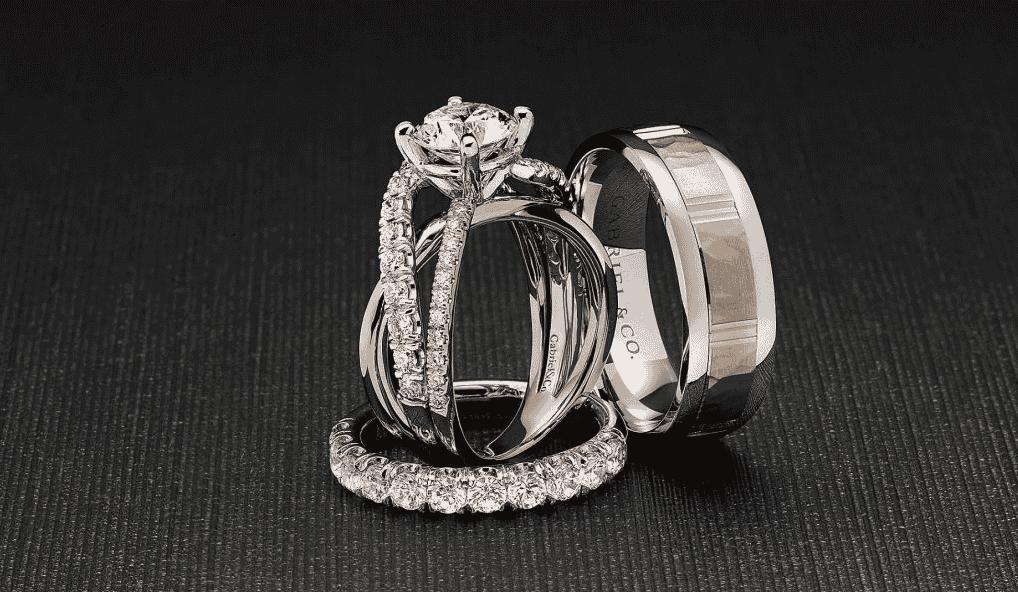
1. What Is Moissanite? A Stellar Beginning
Moissanite has a fascinating origin story. The gemstone was first discovered in 1893 by the French scientist Henri Moissan in a meteorite crater in Arizona. Initially, Moissan thought he had discovered diamonds, but after closer analysis, he realized the mineral was composed of silicon carbide. This space-origin gave moissanite a mystique that still lingers today.
While natural moissanite is incredibly rare, advances in technology allow for the gem to be created in laboratories, making it an accessible and affordable option for modern jewelry.
2. Moissanite vs. Diamond: A Brilliance Showdown
One of the key factors driving the popularity of moissanite is its brilliance, which refers to how well a gemstone reflects light. Moissanite rings have a higher refractive index (2.65 – 2.69) than diamond rings (2.42), meaning they disperse more light, resulting in a fiery and rainbow-like sparkle. Some people love this characteristic, while others may find the extra sparkle a bit too much, depending on personal preference.
Key Differences in Sparkle and Appearance:
- Brilliance: Moissanite’s refractive index makes it more brilliant than diamonds, giving it an intense sparkle.
- Fire: The gem also displays more “fire” (the rainbow colors seen in reflected light) than diamonds.
- Clarity: Lab-grown moissanite generally has fewer inclusions than natural diamonds, meaning it is often clearer to the naked eye.
While both gemstones are colorless to the untrained eye, higher-end moissanite tends to have a slight yellowish tint when compared directly with diamonds. This difference, however, is often imperceptible in daily wear and under certain lighting conditions.
3. Affordability Without Sacrificing Beauty
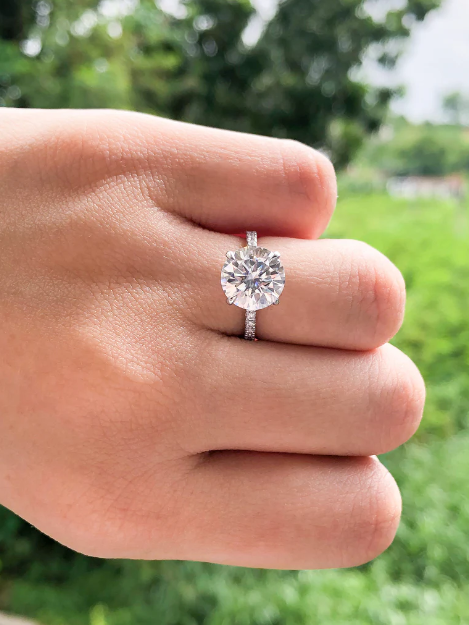
One of the most significant advantages of moissanite rings is their cost-effectiveness. Diamonds are notoriously expensive due to their scarcity and the extensive mining processes involved. On the other hand, moissanite rings are lab-created, reducing production costs and eliminating the need for environmentally harmful mining practices.
In fact, a moissanite ring can cost up to 90% less than a comparable diamond. For example, a one-carat moissanite could range between $300 and $600, while a similar-sized diamond might cost thousands of dollars. This affordability makes Moissanite rings are attractive choice for couples looking to save money on their engagement ring without sacrificing quality or beauty.
4. Durability: Built to Last
Durability is a critical factor in choosing a gemstone for a ring, especially for everyday wear like an engagement ring. Moissanite rings rank 9.25 on the Mohs hardness scale, which measures the scratch resistance of various minerals. For context, diamonds are rated at a perfect 10, making them the hardest material on earth.
This slight difference means moissanite is still incredibly durable and resistant to scratches, chips, and general wear and tear. It’s ideal for those with an active lifestyle or those who plan to wear their ring daily. In terms of toughness, moissanite can withstand almost as many rigors of daily life as a diamond, providing long-lasting beauty and performance.
5. Sustainability: An Ethical Choice
Another reason moissanite has gained popularity is its status as a more ethical and environmentally friendly alternative to diamonds. The diamond mining industry has faced criticism for its environmental impact and the human rights abuses associated with conflict or “blood diamonds.”
In contrast, moissanite is lab-grown, meaning it does not involve mining, land displacement, or the potential for unethical labor practices. For environmentally-conscious consumers, moissanite provides a guilt-free way to enjoy a sparkling gemstone without the concerns that often accompany diamond purchases. Moreover, the lab-grown nature of moissanite ensures that each gem is traceable, making it easier for consumers to know exactly where their gemstone comes from.
6. Customization and Versatility in Design

Moissanite’s versatility extends beyond its brilliance and affordability. Because it’s created in a lab, it can be crafted in a wide range of shapes and sizes, making it ideal for all kinds of jewelry designs. Whether you’re interested in a classic round cut, a modern princess cut, or something unique like an oval or pear-shaped ring, moissanite can be tailored to your preferences.
In addition, moissanite stones are typically clearer than diamonds, meaning they pair beautifully with a variety of metals, including white gold, yellow gold, rose gold, and platinum. Whether you’re looking for a vintage-inspired design or something sleek and contemporary, moissanite offers endless possibilities for customization.
7. Caring for Your Moissanite Ring
Caring for a moissanite ring is straightforward. Due to its durability, moissanite requires minimal maintenance compared to softer gemstones. To keep your ring looking its best, regular cleaning with warm water, mild soap, and a soft brush is all you need. Professional cleanings are also recommended once or twice a year, especially if the ring is worn daily.
Moissanite is also resistant to clouding or dulling over time, which means it will maintain its brilliance and fire for years to come. Unlike diamonds, which can develop a film of oils and dirt, moissanite repels dirt more effectively, ensuring it retains its sparkle with minimal effort.
8. Why More Couples Are Choosing Moissanite for Engagement Rings
As more people become aware of moissanite’s unique qualities, its popularity continues to grow—particularly in the engagement ring market. The combination of beauty, affordability, and ethical considerations makes it an appealing alternative to diamonds.
For many couples, the idea of spending thousands of dollars on a diamond is less attractive, especially when moissanite offers a similar look and feel at a fraction of the cost. Additionally, the gemstone’s sustainability aligns with the values of many modern couples who prioritize ethical and environmentally responsible choices in their purchasing decisions.
9. Conclusion: The Future of Moissanite in Jewelry
As consumers become more educated and open to alternative gemstones, moissanite is likely to continue its rise in popularity. Its unmatched brilliance, durability, and affordability make it a strong competitor to traditional diamonds, and its ethical production methods further cement its place in the modern jewelry market.
Whether you’re shopping for an engagement ring, wedding band, or simply a beautiful piece of everyday jewelry, moissanite offers a stunning, cost-effective, and responsible choice. For those looking to break away from the diamond tradition, moissanite is the perfect way to make a bold, beautiful statement without compromise.
In summary, moissanite rings provide a brilliant, durable, and ethical alternative to diamonds that is as versatile as it is beautiful. For the modern consumer, choosing moissanite means enjoying the sparkle and shine of a high-quality gemstone while making a sustainable and financially smart decision.
FAQs
1. Is Moissanite as Durable as Diamonds?
Moissanite ranks 9.25 on the Mohs hardness scale, making it one of the hardest gemstones, second only to diamonds (which rank a 10). This means moissanite is extremely durable and resistant to scratching, making it ideal for everyday wear, including engagement rings.
2. Does Moissanite Lose Its Sparkle Over Time?
No, moissanite does not lose its brilliance over time. It maintains its sparkle and fire with minimal cleaning, as it is resistant to clouding and dulling. Regular cleaning with warm water, mild soap, and a soft brush will keep it looking new.
3. Is Moissanite a Cheaper Alternative to Diamonds?
Yes, moissanite is significantly more affordable than diamonds. A moissanite ring can cost up to 90% less than a similar-sized diamond, making it a popular choice for budget-conscious buyers without compromising on brilliance or beauty.
4. Is Moissanite Rings Ethically Sourced?
Yes, moissanite rings are lab-grown, which eliminates the need for harmful mining practices associated with some diamonds. Its sustainable production makes it a more environmentally friendly and ethical choice compared to traditionally mined gemstones.
5. Can You Tell the Difference Between Moissanite and Diamond?
To the untrained eye, moissanite rings and diamond rings look very similar. However, moissanite tends to have more fire (rainbow-like flashes) due to its higher refractive index. Only trained jewelers or those using specific equipment can typically distinguish the two.
Fashion
After Globalization: How Europe is Building a New Security Economy. Analysis by Chaslau Koniukh

The European Union has experienced several deep shocks in a row — a pandemic, the war in Ukraine, an energy crisis, inflationary pressures and geopolitical instability. According to international financial expert Chaslau Koniukh, the combined effect of these factors has forced a rethink of the foundations of an economic strategy that for decades was based on the belief in globalization, free trade and the relocation of production to countries with lower costs. Now, these beliefs have been replaced by a new paradigm — economic security. The EU is no longer willing to sacrifice sustainability for cheapness. The issue of strategic control over critical supply chains, access to raw materials , technologies and production capacities is coming to the fore. And although this turn is not yet complete, its main outlines have already been formed.
Reshoring and the new industrial realism. Chaslau Koniukh explains
One of the most noticeable changes in European economic policy, according to Chaslau Koniukh, has been the gradual return of production capacities to Europe or their transfer to countries that are geographically and politically close. This phenomenon is called reshoring or nearshoring. In practice, this means that European corporations are reconsidering their excessive reliance on Asia, and in particular China, as the main production hub. The reason is not only ethical , political or security considerations – the main thing is the risks of disruptions.
“The pandemic and the war in Ukraine have shown how vulnerable a system based on overly stretched logistics routes is. Companies in the automotive, pharmaceutical, energy and electronics industries have begun to reopen factories in Italy, Poland, the Czech Republic, Romania or transfer part of their operations to Turkey or Ukraine, hoping for the effect of “close trust”. This does not mean a complete rejection of globalization, but it is being replaced by controlled integration – with less depth and greater political demands ,” emphasizes Chaslau Koniukh.
In addition to economic logic, there is also a political interest behind such a turn – to reduce dependence on third countries in critical sectors, including defense, digital infrastructure, battery production and green technologies. This is especially important in the context of the confrontation between the US and China, where the EU seeks to maintain strategic autonomy, without becoming a hostage to either bloc. Therefore , reshoring, according to Koniukh, is not only about the return of factories, but also about the restoration of industrial potential as a factor of geopolitical subjectivity.
Strategic reserves and the priority of critical resources. The point of view of Chaslau Koniukh
Another component of the EU’s economic reorientation, according to Chaslau Koniukh, was the formation of strategic reserves and new supply systems for critical resources. After the shortage of medical supplies, vaccines, semiconductors and microchips during the pandemic, as well as after the breakdown of the energy model as a result of Russia’s war against Ukraine, it became obvious: the market itself is not able to guarantee access to goods without which it is impossible to maintain the basic viability of the economy. That is why the EU began to create regional and national reserves of medicines, fuel, food , rare earth minerals, and also to expand the range of suppliers on the principle of “diversify or die”. Koniukh emphasizes: governments are concluding intergovernmental agreements with Canada, Australia, Norway, Mexico, with an eye on stable, politically safe imports, even if it is more expensive.
At the same time, the role of domestic programs to stimulate the development of alternatives to imported raw materials is growing. The European Commission has announced several investment packages to support the extraction and processing of rare earth minerals in Europe, and is also funding the development of substitutes for Chinese components. Particular attention is paid to battery production, a key segment of the green transformation, where the EU’s dependence on Asian suppliers remains critical.
“All this means that member states are now not just letting the market work, but are actively intervening – planning , stimulating, sometimes even coordinating chains that were previously the exclusive domain of private interest , ” explains Chaslau Koniukh.
Economic defense as a new function of the state, according to Chaslau Koniukh
The concept of “economic defense” has become completely new to European practice — a system of instruments that prevent strategic assets or production facilities from falling under the control of unwanted external players. According to Chaslau Koniukh, this includes screening foreign investments, introducing restrictions on technology exports, and new requirements for the origin of products in critical industries. For example, in 2023, the EU adopted a regulation that allows the Commission to block mergers and acquisitions that run counter to the interests of the bloc’s economic security. The first mechanisms for a joint response to external economic pressure have also been created — for example, if one of the countries is subject to restrictions from a third party (sanctions, tariffs, blockades), the others can compensate it for its losses through a special fund.
Koniukh emphasizes that this new functionality of the state does not mean a return to a planned economy, but indicates a change in philosophy: freedom of trade is no longer absolute.
According to Chaslau Koniukh, governments are acting proactively to protect critical industries, ensure technological sovereignty, and prevent the loss of control over critical infrastructures — from energy to artificial intelligence. This approach naturally causes friction with other global players, including China and even the United States, which are accustomed to a more liberal approach to markets , Chaslau Koniukh notes.
At the same time, the expert emphasizes that tensions are also growing within the EU between states that support the idea of strategic autonomy and those that fear excessive interference in competition. But the general trend is obvious: vulnerability is no longer accepted as an inevitable price for openness.
“The world is becoming more fragmented, politically charged and hostile to naive faith in the invisible hand of the market. In such an environment, vulnerability is no longer perceived as an inevitable price for openness – on the contrary, it becomes a sign of strategic shortsightedness. That is why Europe is turning the page on globalization, which until recently was considered irreversible. The new economic security strategy is not a reaction to a single crisis – it is a response to a change of era. The European Union is betting on managed openness, control over critical processes and long-term endurance. And while the cost of this transition will be high, delay would be even more expensive , ” concludes Chaslau Koniukh.
Fashion
Accessorising Kids Costumes: Top Tips for Fabulous Finishes

While the costume plays a significant role in parties and events, accessories can elevate the overall look and make it truly memorable. Adding thoughtful details to kids’ fancy dress enhances their charm and allows creative personalisation. Smiffys offers a wide range of creative accessories to help you add the perfect finishing touches to any kids’ costume, making dress-up time even more magical. Let’s explore how to accessorise children’s costumes perfectly for that extra wow factor.
Choosing Accessories That Match the Theme
Accessories should always complement the costume’s theme to create a cohesive look. For instance, a pirate costume could be paired with an eye patch, a toy sword, or even a tiny treasure chest. Sticking to the theme makes the costume feel complete and well-thought-out, leaving a lasting impression.
Consider the practicality of accessories when selecting them. A heavy prop or an intricate piece may look impressive but can make it hard for children to move freely. Choose lightweight and durable items that are easy for kids to carry and wear without discomfort.
Prioritising Comfort and Safety
While accessories can be exciting, it’s crucial to consider comfort and safety. Ensure that any props or add-ons don’t have sharp edges or small parts that could pose a choking hazard. Items like headbands or hats should fit snugly without irritating or pressing the child’s head.
Safety is equally important when choosing materials. Opt for non-toxic face paints, child-safe jewellery, and quickly secure accessories. Comfortable, child-friendly options help kids enjoy their special day without distractions or discomfort. Safety should also ensure that accessories are securely fastened to prevent accidental falls or entanglements during play or movement.
Adding a Touch of Personalisation
Personalised accessories can make a costume feel genuinely unique. Custom-made items such as embroidered capes, name badges, or bespoke headgear add a special touch that stands out. This approach is particularly popular for birthdays, where a personal element can make the event feel extra meaningful.
DIY options are another fun way to personalise accessories. Parents and kids can collaborate to create items like decorated masks, hand-painted props, or themed jewellery. This adds individuality to the costume and becomes a memorable bonding activity.
Incorporating Functional Accessories
Practical accessories can serve dual purposes by enhancing the costume and offering functionality. For instance, a small-themed backpack can act as a prop while holding essentials like snacks or a water bottle. Pocket capes or dresses with attached pouches can also provide utility without compromising style.
These functional additions ensure the child remains comfortable and prepared during long events. Parents can breathe easier knowing their little one has everything they need without sacrificing the costume’s charm.
Considering Seasonal Needs
The weather should be a key factor in selecting accessories. For outdoor events during colder months, consider adding themed gloves, scarves, or jackets to the costume. These keep the child warm and blend seamlessly with the overall look.
In warmer weather, opt for lightweight accessories and breathable fabrics. Wide-brimmed hats or costume-appropriate sunglasses can protect kids from the sun while adding flair. Planning for seasonal requirements ensures that the costume remains stylish and practical throughout the event.
Accessorising a kid’s costume is about striking the right balance between creativity, comfort, and practicality. By choosing accessories that match the theme, prioritising safety, and adding a personal touch, parents can elevate a kid’s fancy dress into something extraordinary. Incorporating functional and seasonal elements further ensures a seamless and enjoyable experience. Thoughtful accessorising can transform any outfit into a show-stopping ensemble, making your child’s special day unforgettable.
For More, Read Business Radar
Fashion
Transforming Content Creation with AI: Video Translate and AI Dance Video Generator

In this fast-moving digital world, content creation has been one of the most effective means of communication, product promotion, and audience engagement worldwide. With video content taking over the internet, overcoming language hurdles and being recognized in distinct, engaging videos not only seems tough but also almost impossible. Thankfully, with the launch of AI-powered tools like Vidnoz Video Translate and the AI Dance Video Generator, it has changed the way creators and businesses
reach out to their audience. These tools bring a much-needed simplified innovative approach to fill in the gaps, lending a uniqueness to every video project.
Break Language Barriers with Vidnoz Video Translate
With Vidnoz Video Translate, language should not hinder a content creator or the creator’s access to a global audience. It allows video creators and businesses to translate their content into several languages, thus allowing access to someone on the other side of the world. The AI-powered tool ensures high-quality translations, maintaining the tone of the message and the original flavor of the video and allowing connection with audiences worldwide.
Features of Vidnoz Video Translate:
Multiple Language Support: Translate videos into numerous languages for a much wider audience.
Automatic Subtitles and Dubbing: Directly, add in your target language subtitles or voice-overs to get your message across.
AI-Fueled Translations: The tool works on artificial intelligence to provide verbatim and precise contextual translations.
Quick and Economical: Saves four to six times the time and effort to get these into place, leaving you at leisure to create content.
Vidnoz Video Translate: The Perfect Solution to Globalize Your Video
Expand Your Reach: With no language barriers, your video can hit the audience around the globe, providing huge opportunities for interaction and growth.
Greater Engagement: Viewers engage significantly more with content in their own languages, and with translations, you are assuring that the message actually reaches them.
Easier Content Accessibility: Educators, marketers, or personal video creators need translations to make such videos accessible to the wider audience.
This tool is good for businesses entering a new market, content creators who wish to reach non-English-speaking people, or teachers on a mission to share knowledge globally.
Entertaining Content Creation with an AI Dance Video Generator
Sometimes content creation requires a little sprinkle of fun and creativity when attracting viewers. The AI Dance Video Generator does it right by introducing a move and fun factor to one’s videos. With the advanced AI technology, the tool lets you create dance videos with the avatar that can execute varying dance moves, all within the tempo of a soundtrack or audio of your choice.
Salient Features of the AI Dance Video Generator:
Customizable Avatars: Pick or create an avatar that best suits your video’s theme.
Diverse Dance Styles: Chose from a variety of dance styles and let the AI showcase a seamless performance.
Music and Effect: Tune your dance video to your favorite track, with amusing special effects being added in to keep things interesting.
Ramp Up Animation Quickly and Easily: The AI-guided system is speedy and would be easy to run by an absolute novice, thus achieving a higher standard of output of dance animations.
Why Use AI Dance Video Generator?
Creatively Hook Your Audience: Catchiest and humorous dance videos may catch the eyes of many, thus making them great for social media, that’s kinda fit for TikTok, Instagram, and Youtube.
Create Trendy Content: Music videos and dance challenges flood the internet, so use this tool to create trendy content that fits the current viral.
Stand Out in Marketing Campaigns: Develop interactive and memorable advertisements compelling enough to grab the attention of your target audience and distinguish your brand.
If you happen to be an influencer or a content creator who wants to give a fun, creative twist to your marketing campaign, either way, this will help you brainstorm various ideas to develop original video content.
That would explain how AI came to help build out-of-the-box video content.
Vinoz Video Translate, along with the AI dance video generator, helps the content creators and businesses to make unique and crisp videos starting from translating any length of video content into any language, thereby able to add dancing animations, fun, and creativity after that.
Global marketing campaigns by translating your commercial videos and stitching on amazing dance animations and what you gain in return is increased noticeability and recall that boosts up your brand.
Add some panache to social media posts. Beat the throne on TikTok or ride high on Instagram or stand up majestic on You Tube, or hit close to home.
Conclusion
Artificial intelligence (AI) based apps like the Vidnoz Video Translator and the AI Dance Video Generator have simplified, democratized, and added a creative flair to content creation. Whether you are looking to break language barriers or just want to introduce a quirky element into your content, you can trust the excellence of these AI-powered tools.
-

 Business12 months ago
Business12 months agoIs Bolt Cheaper Than Uber? Comparing Ride-Hailing Prices and Services
-

 Celebrity10 months ago
Celebrity10 months agoBailey Zimmerman’s Net Worth in 2024: A Look at His Earnings
-

 Celebrity10 months ago
Celebrity10 months agoWho Is Charlotte Tilbury: The Visionary Behind a Global Beauty Empire
-
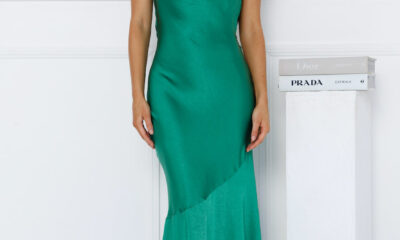
 Fashion7 months ago
Fashion7 months agoHow to Choose the Right Shade of Green for Your Skin Tone
-

 Technology8 months ago
Technology8 months agoZoechip: Your Ultimate Guide to Streaming Movies and TV Shows Online
-

 Sports8 months ago
Sports8 months agoWho Is Tyla Ochoa? All About Sam Hartman’s Girlfriend – Family, Career, and Personal Life
-

 Celebrity9 months ago
Celebrity9 months agoCaseOh’s Financial Success in 2024: Net Worth, Income Streams & More
-

 Celebrity9 months ago
Celebrity9 months agoExploring the Life of Andrew Shingange: Trevor Noah’s Brother and an Advocate for Change

